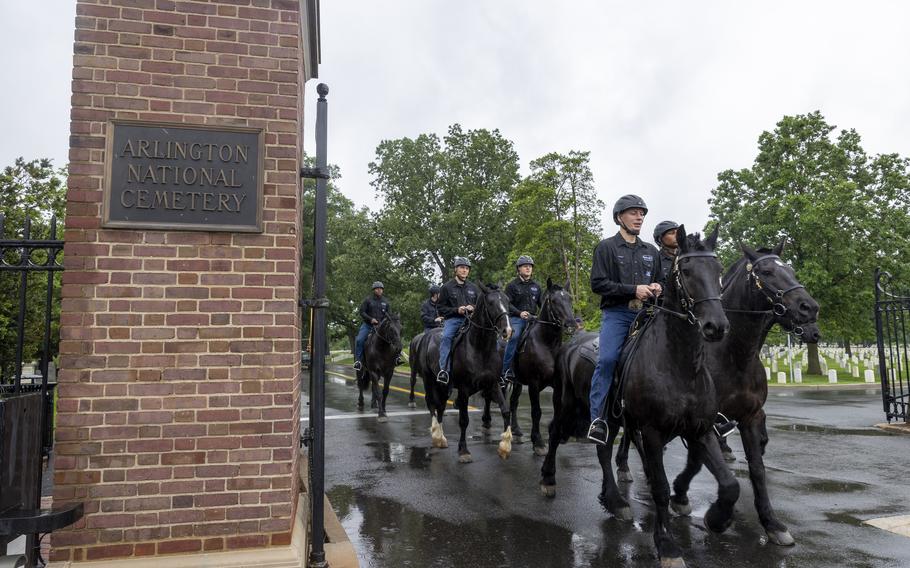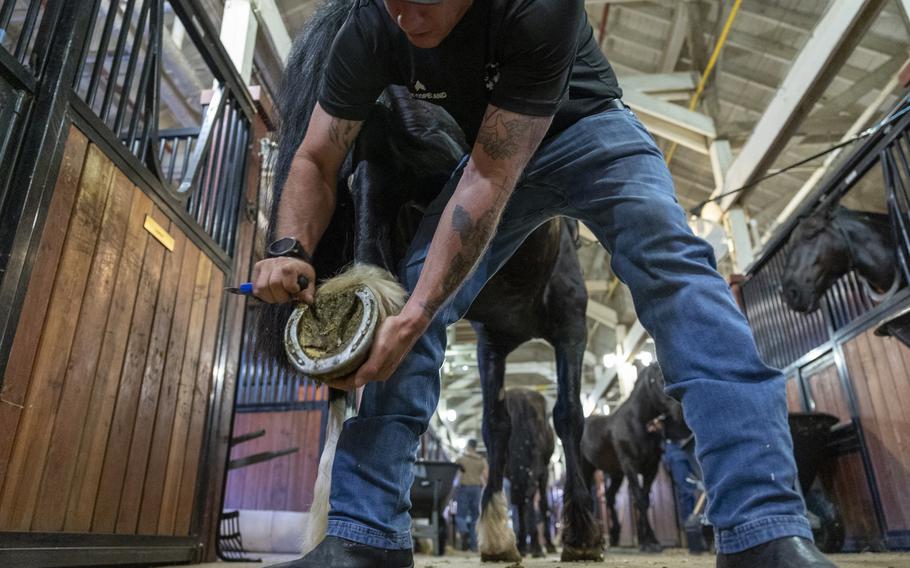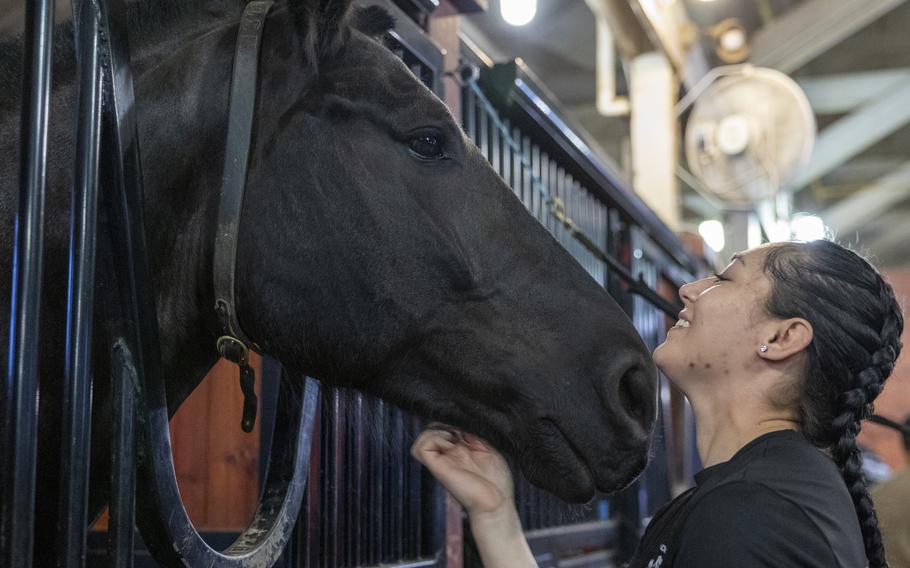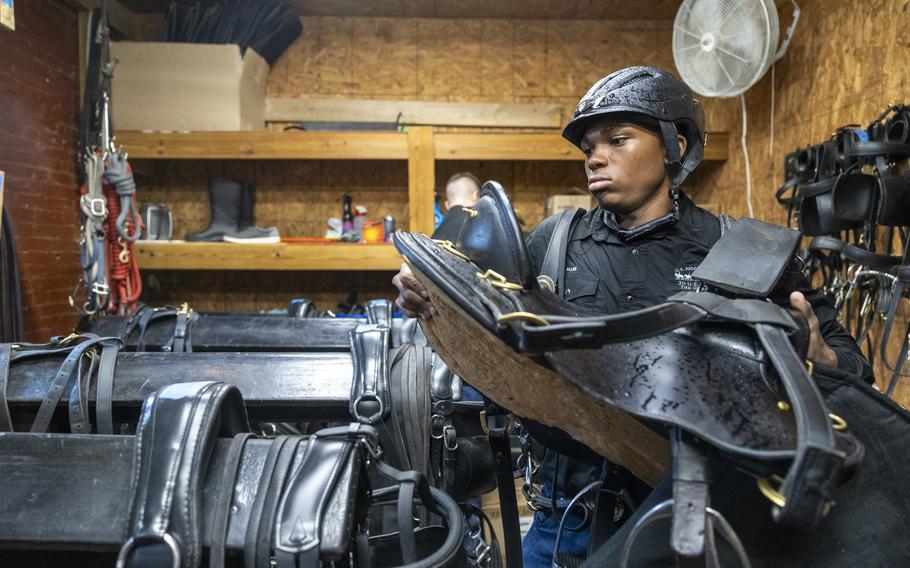
The 3rd U.S. Infantry Regiment (The Old Guard) trains horses on Tuesday, May 13, 2025, at Arlington National Cemetery in Arlington, Va. (Eric Kayne/Stars and Stripes)
WASHINGTON — The horse-drawn caissons of the 3rd Infantry Regiment that have carried the caskets of deceased service members to gravesites at Arlington National Cemetery since 1948 are scheduled to formally resume service on June 2 after a two-year suspension over concerns for the herd’s health and welfare.
Major reforms to the caisson detachment have been undertaken since two sick horses were euthanized because of colon impaction, the Army said.
The caisson program has been overhauled with a focus on increased training for the soldiers, improvements to facilities and upgraded equipment, said Maj. John W. Strickland.
Caisson funerals will be limited basis to two per day and up to 10 per week. “This is not the same program. It has been completely rebuilt,” Strickland said.
The caissons are horse-drawn wagons primarily used in funerals. Pulled by six horses and three riders, they serve as dignified transport for the flag-draped casket in funeral processions.
“Being the first team back to the cemetery is a significant occasion, but I am confident we will carry out the mission flawlessly,” said Staff Sgt. Alex Horta, a squad leader in the caisson detachment.
In May 2023, the Army canceled the iconic horse-drawn funerals, after an internal investigation revealed poor living conditions for the animals, malnourishment and a lack of open space for the herd, according to Maj. Gen. Trevor Bredenkamp, commander of the Army Military District of Washington.
Horses had been confined to small lots littered with debris and manure. They were fed low-quality hay, and some ingested sand and gravel.
“Caisson-pulling military horses were dying in 2022 because of the Army’s failure to provide proper food, veterinary care, pastureland and stables for the herd,” said Rep. Morgan Luttrell, a Texas Republican and Navy veteran who grew up on a horse ranch.
“Our caisson platoon should be the most elite organization of its kind on the planet,” Luttrell said.
Before the pause, some of the horses were working 45 days straight although they were supposed to get two weeks of rest after 14 days of work, the Defense Department said.
Formalized more than 75 years ago, the tradition of horse-drawn funeral processions is “one of the most iconic pieces of U.S. military history, serving as the mounted escort to our nation’s fallen,” according to the Joint Task Force-National Capital Region and the U.S. Army Military District of Washington.
In April, the Army announced plans to resume the caisson program after redesigning it. “After careful consideration and coordination, we are pleased to reintegrate the caisson conveyance into funeral services at Arlington National Cemetery, a solemn and revered tradition,” said Karen Durham-Aguilera, executive director of Army National Military Cemeteries.
When service resumes, horse-drawn processions will be limited to service members killed in action, Medal of Honor or Prisoner of War Medal recipients, senior noncommissioned officers (E-9), senior warrant officers (CW-5) and senior commissioned officers (O-6 and above).
In December, Congress passed the Honoring Our Heroes with Dignity Act as part of the 2025 National Defense Authorization Act, which included funds to update historic stables at Joint Base Meyer-Henderson Hall. The legislation also mandated standardized training and certification for riders.
“Training has also shifted from impromptu methods to a structured pipeline,” the Defense Department said.
Caisson soldiers must have about 20 weeks of training, beginning with basic rider instruction to advanced training in Ocala, Fla., before they assume their roles within the unit. Before the pause, training lasted for about eight weeks, Strickland said.

Sgt. Damien Copeland cleans around a horseshoe on Tuesday, May 13, 2025, in Arlington, Va. (Eric Kayne/Stars and Stripes)
“The chance to work with the horses every day and the honor of escorting our nation’s fallen to their final resting place with them had me intrigued, so I decided to try out,” said Sgt. Damien Copeland, who joined the Army in March 2022 and was assigned to the caisson program after basic training. “Less than 12 of us made it through to make it into the basic horsemanship training program to have the chance of graduating and working with the horses.”
Renovations underway at the stables include increasing stall size, enhancing the footing in and around the stalls with rubberized pavers, improving the ventilation system and rebuilding paddocks.
From the caissons to the saddles, aging and worn-out equipment has been replaced. A new caisson, designed by the Army Combat Capabilities Development Command, uses modern materials to reduce the wagon’s weight by more than 1,000 pounds, the Army said. Earlier versions of the wagon weighed 1½ tons.
The herd size is about 50 horses, and the Army is looking to procure additional horses to build more squads, Strickland said.
Many of the horses are Percheron, a breed with a large frame and calm temperament. Each squad consists of 11 horses — seven horses for the team and four that serve in a backup capacity, he said.
The program previously had about 60 horses. About 50 were retired to farms across the country, Strickland said.
“Those that served 10 years or more or that were over a certain age were retired,” he said.
The horses live and train at the Nova Equestrian Center in Loudon County, Va. The quarters provide the space and training facilities necessary to keep the herd healthy and fit, Strickland said.
Squads rotate to Joint Base Myer-Henderson Hall in Virginia for specialized training then return to the 50-acre equestrian center, where there is grazing land.
“Going forward the squads will have a dedicated work-to-rest cycle where we will stable the horses here on Fort Myer for two weeks with a two-week period at the [equestrian center] for rest and reconditioning,” Strickland said.
Army officials said they consulted with world-class equine experts as they rebuilt the program over the past two years.
They included David O’Connor, an Olympic equestrian; Chester Weber, an equestrian athlete with a background in horse driving teams; and Jim Westbrook, who has extensive experience as a trainer in horse-driving competitions.
“The caisson detachment maintains a support staff and command team reporting directly to the regimental commander, supplemented by civilian trainers and veterinary professionals,” the Army said.
Horta, who joined the caisson program in 2024, said he settles for nothing less than perfect execution for himself and the caisson detachment he leads with the 3rd U.S. Infantry Regiment.
“We get to do our mission every single day. The biggest difference is that we have to get it right every time. Every family deserves a perfect ceremony, and that’s what we try to provide,” said Horta, who has served in the Army since 2017 with deployments to Germany, Poland and South Korea.
With a greater emphasis on training and education, the Army is reexamining rotations so service members don’t have to exit the program after achieving proficiency.
“There is no formal length of time a soldier serves in the caisson detachment, but we are actively pursuing options to retain soldiers longer,” Strickland said.
One of the first things Horta said he learned after joining the caisson detachment was the importance of predictability, routine and a calm presence for horses and the riders.
“After spending eight years in the Army, I was very accustomed to saying commands a certain way. Here, it’s completely different. Most of the commands are subtle hand gestures and head nods,” Horta said.

Sgt. Natalee Silva nuzzles Goose, a Percheron-breed horse, on Tuesday, May 13, 2025, in Arlington, Va. (Eric Kayne/Stars and Stripes)
Sgt. Natalee Silva said maintaining “ceremonial composure” is critical to the role.
“Being a part of this regiment teaches a lot of discipline and attention to detail,” said Silva, who joined the Arizona National Guard as a truck driver and later served on the border with Mexico.
“I signed a new contract to become an infantryman shortly after I left the border mission and went active duty. After going through OSUT I was stationed here at Fort Myer,” Silva said, referring to One Station Unit Training, which is 22 weeks of training for recruits at a single base. She tried out for the caisson program in 2023.
Mornings start just after dawn for the caisson detachment. Responsibilities include general care for the horses, cleaning and maintenance of equipment and other requirements in and around the barn.
“From Day 1 we are taught everything that it takes to care for and work with the military horses,” Copeland said. “Our basic horsemanship training taught us about groundwork, proper riding, the caisson mission and understanding the feel of the horses and their mannerisms.”
Although several of the caisson soldiers have prior experience handling horses, it was not an initial requirement, Strickland said.
“My grandfather owns a ranch, and my father was a team roper growing up so I was sometimes around horses as a kid,” Silva said.
“When I was 12, my family bought a small plot of land in north Texas,” Horta said. “That’s where my passion for horses began. Shorty after that, I spent every day after school in the saddle, riding my own horses and helping neighbors condition theirs.”
The caisson detachment recently provided ceremonial services to honor former President Jimmy Carter, who died Dec. 29.
“It was a prideful moment working the state funeral. It was an honor for my team and I to accompany President Carter one last time through Washington, D.C.,” Horta said. “Above all, we are extremely proud of the horses’ ability to maintain composure and feel comfortable among the large crowds.”
The Army acknowledged the achievement of transforming the program over two years.
“A 77-year legacy was reformed and revitalized. This brought forward a tradition of honoring American service members in line with modern science, and creating programs, partnerships and practices that would allow caisson to sustain itself well into the future,” the Army said in a formal statement.
Horta has been in the process of reviewing the horses and riders in their various positions, a final step in preparation for the official return to Arlington National Cemtery.
“We prioritize our horses,” Horta said. “My team and I ensure we maintain a safe and habitable environment fit for the horses to feel comfortable. We coordinate training with other platoons on base to prepare ourselves and the horses for highly prestigious missions and honoring our nation’s fallen.”

Following a training ride, Pfc. Joshua Allen puts up his saddle in the tack room on Tuesday, May 13, 2025 in Arlington, Va. (Eric Kayne/Stars and Stripes)